“Catwalk”
Written by Paul Dini
Directed by Boyd Kirkland
Episode #074
Music by Kristopher Carter
Animation by Dong Yang Animation, Inc.
Original Airdate?September 13th, 1995
Plot: Scarface and the Ventriloquist tempt Catwoman into resuming her life of crime, but then betray her on her very first score.
Okay, it took a while, but we finally get a good Catwoman episode. In fact, we get a great one. The animation for “Catwalk” is spectacular, with Boyd Kirkland pulling out all the stops. There’s a balletic, dreamlike montage sequence with Altieri-esque vertigo inducing falls. There’s brilliant fight choreography throughout—between Catwoman and Batman, Catwoman and Scarface’s thugs, and a rematch between Batman and Rhino that puts their first fight to shame. Most importantly, Catwoman finally gets a plot worthy of her?Catwoman is framed for a crime that she may have actually committed?which is so good that Batman: the Animated Series will reuse it two more times, and it’s great each time.
Since “The Cat and the Claw,” Catwoman has had a great voice actress (Adrienne Barbeau), a great dynamic with Batman, and a pretty good costume design. The problem is that, so far, she hasn’t really been a villain, and she just isn’t that interesting as a vigilante that Batman constantly has to rescue. In “Catwalk,” Paul Dini and Kirkland re-position Catwoman where she belongs, just on the wrong side of the hero/villain divide.
In the opening flashback, Selina Kyle laments the freedom she lost when she quit burglary, freedom from the law, from societal expectations, even from gravity itself. Like a cat in a cage, Selina chafes under any restrictions, even the mild ones placed upon intelligent, attractive blondes who are also friends with Bruce Wayne. Catwoman does not steal because she needs money. She steals because, on some level, she doesn’t believe in the concept of property. If she can take something and get away with it, why shouldn’t she have it?
Freedom from everything, even the law, is a seductive fantasy. It’s certainly part of the appeal of superheroes in general, and Batman in particular. It’s not like Batman lets a little thing like due process or civil rights get in the way of his pursuit of justice. But Batman, at least, lives within his own code. Catwoman’s freedom is purer, an anarchistic solipsism that places her wants and needs above all else. Brilliantly, “Catwalk” demonstrates how Catwoman’s selfish independence shifts her from hero to victim to villain and back again, all depending on the circumstance.
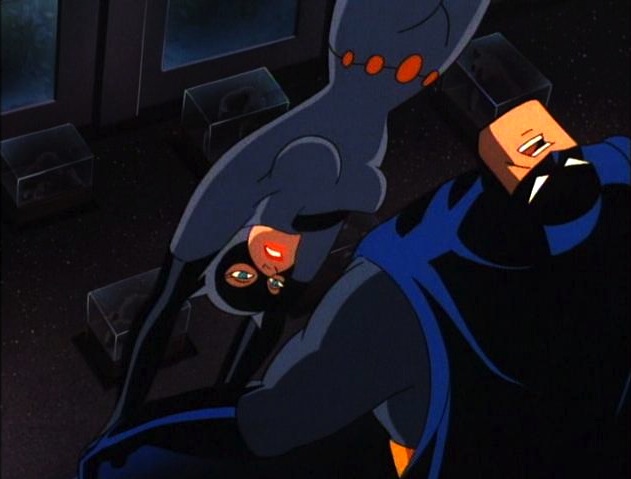
Catwoman gets back in the game with the awesome line “extinction is for wimps.” On the one hand, that’s real Fuck Yeah badassery, a defiant cry of “I will survive” or “We are canceling the apocalypse.” On the other hand, it shows a lack of empathy, a belief that the weak deserve death. What happened to the Selina that robbed from the rich and gave to the cats? As with Poison Ivy in “House and Garden,” Paul Dini and Kirkland reveal that Catwoman’s previous environmental concerns were just excuses for the crimes she wanted to commit anyway. Scarface even mocks her previous claims of helping “poor little stuffed critters what never had a chance.” At this point, Catwoman is a villain, robbing Veronica Vreeland who, for all her faults, doesn’t deserve to have every party she throws ruined by supervillains.
But Scarface betrays Catwoman immediately, and suddenly we see the first problem with Catwoman’s freedom, she cannot turn to the authorities, or Batman, to save her anymore. That Batman insists on helping anyway, forcing Catwoman to lie and then fight him to maintain her independence, shifts Catwoman from villain to victim to hero. After being helpless too many times previously, fighting her former protector to maintain her freedom makes her admirable. That she fights him on top of a blue whale hanging in a museum makes her awesome. (Apparently, the Gotham Natural History museum just IS the New York Natural History Museum, and Veronica’s great-grandfather Stanton Vreeland is Theodore Roosevelt.)
And as long as she’s fighting Scarface and his goons Rhino and Mugsy, Catwoman remains a hero, because Scarface is a horrible, violent monster, a killer in ways that Catwoman is not. Also, Scarface is and remains a wooden dummy, so Selina can crush him with a ton of logs and the moment is exciting and cathartic, not horrifying. But then she turns on the Ventriloquist himself, threatening to carve him up until she finds Scarface, and in an instant, our sympathies shift and Catwoman becomes a villain again. Again, Selina hasn’t changed, she’s still fighting to maintain her independence. But depending on whom she’s fighting, she’s a hero or a villain.
The use of Scarface and the Ventriloquist in this episode is brilliant. Not only does “Catwalk” play into the Ventriloquist’s theme of manipulation and being a “puppet master,” but Dini and Kirkland couldn’t play the same trick of radically shifting sympathies as well with any other Batman villain. There’s just no other character that has that clear, physical divide between the half it’s okay to hit, and the half you need to leave alone.
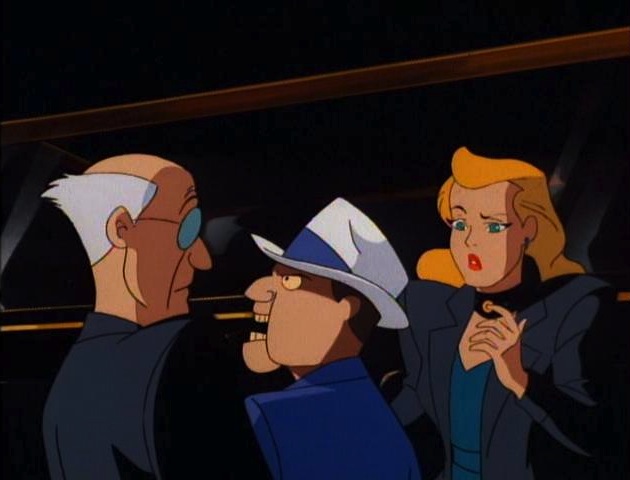
Also (surprisingly), Scarface and Catwoman have great chemistry. Their dialogue, a loving parody of ’30s gangster films, sings. (“You’re boring me, log.”) Unlike the Arkham inmates, who just accept a dummy crime boss as par for the course, Catwoman is one of the “sane” villains, and so laughs in Scarface’s, um, face. Still, Scarface’s heists are perfectly planned, so she goes along with his scheme (replacing the similarly skeptical Ratso, who doesn’t return from “Read my Lips.” Do I want to know what happened to him?) Meanwhile, Scarface acts like a big shot crime boss, complete with a chauvinistic attitude. Scarface flirts with Catwoman even as he sets her up, and worries his fly’s undone in front of her. This is even funnier because, well, Scarface is almost certainly not anatomically correct.
Once Batman rescues the Ventriloquist, however, we learn that the final cost of Catwoman’s independence. Freedom from everything means freedom from obligations, and that means she can no longer have meaningful relationships with anyone (at least, anyone human). No more personal assistant, Maven. No more car rides and parties with Bruce Wayne. And Catwoman’s only interactions with Batman from now on is their kinky brand of flirt-fighting that she enjoys so much, and he tolerates. (“I don’t know whether to bite you or kiss you.” “Later.”) The only way for Catwoman to be truly free is to be forever alone.
Of all of the recidivism episodes, “Catwalk” is certainly the most painful for Batman, both because Catwoman is the villain Batman is closest to—the one he likely actually loves—and also because Catwoman was reformed for so long. So not only is this a personal betrayal and loss for Bruce, but it bodes ill for every other criminal that claims to give up crime. Even if they’re sincere, even if they don’t go back to crime right away, “Catwalk” argues that they will inevitably return to crime. It’s only a matter of when. Catwoman’s non-explanation, “I have to be who I am,” echoes Killer Croc’s non-explanation, “bein’ myself.” It’s a lesson Batman is learning, painfully. As soon as he hears about the break in at the museum, he bugs Catwoman’s cat. As much as he wants to, he knows he can’t trust Catwoman. Ever again.
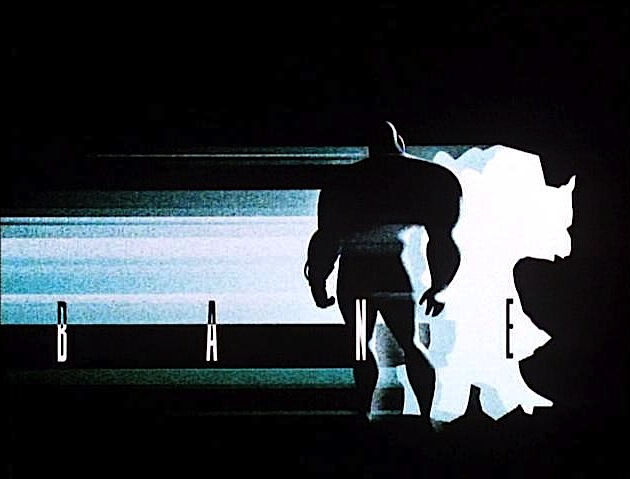
“Bane”
Written by Mitch Brian
Directed by Kevin Altieri
Episode #075
Music by Lolita Ritmanis
Animation by Dong Yang Animation, Inc.
Original Airdate?September 10th, 1994
Plot: Rupert Thorne hires super assassin Bane to take care of Batman once and for all.
Chuck Dixon, Doug Moench, and Graham Nolan introduced super-steroid-powered luchador Bane in January 1993, making Bane the first villain created for the comics after the show first aired to appear in an episode. However, Bane’s appearance was almost inevitable. Bane, after all, is the main villain in the super popular storyline Knightfall, where he breaks Batman’s back, necessitating the introduction of a new Batman. After that, Bane has extra cache: he’s the villain who beat Batman.
That’s something that Kevin Altieri’s direction captures really well: the sense of menace emanating from Bane. Whether it’s his generally calm demeanor, Henry Silva’s suave line delivery, or just the way Bane fills every room that he’s in, Bane seems in control all the time. And that’s before he starts fighting, using the super drug Venom to double his strength, putting the equally huge Killer Croc in traction, throwing Robin around like a rag doll, and grappling with Batman before finally going for the back breaker. Altieri does an exceptionally good job with the Venom-induced transformations. Bane is already a giant before taking the drug, Venom just makes him slightly bigger, and much more veiny, a noticeable, threatening physical change without being cartoony or magical. Bane is portrayed as a juggernaut and Bane breaking the Dark Knight over his knee seems inevitable.
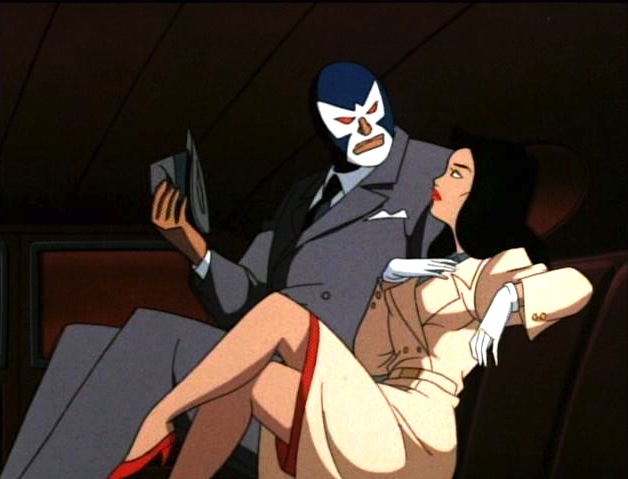
However, that inevitable moment, intentionally, turns out to be anti-climactic. The Animated Series isn’t going to break Batman’s back and replace him with Azrael, and Ra’s al Ghul and the Joker already fill the arch-villain roles for the series, so there isn’t really room for Bane. Therefore, Bane turns out to be a paper tiger, easily defeated by basically pushing a button on Bane’s own costume, overdosing Bane with Venom which pushes Bane through some painful, spectacular, and oh so cathartic further transformations before Batman finally has mercy on him.
I will give writer Mitch Brian a lot of credit though. Beating Bane by overdosing him with Venom is a lot more clever and makes more sense than cutting off Bane’s supply of Venom, which happens in every other fight with Bane I’ve seen or read. If cutting the exposed tube on Bane’s arm immediately drops the villain, then it becomes such an obvious “off switch” that he might as well come with a note attached saying “In case of emergency, pull cord.” It gets even dumber if Bane deflates to a 98-pound weakling when unplugged. Looking at you, Batman and Robin. Tellingly, comics Bane ditched the exposed apparatus after his first defeat, though his addiction to Venom continues to haunt him.
Brian and Altieri really play up Bane’s luchador affectations. He’s all about honor. Bane’s fighting style focuses on wrestling holds, and he refers to his chosen battleground as his arena. Like any good luchador, Bane refuses to take off his mask, even when flying coach, will take pleasure in removing Batman and Robin’s mask, and is truly defeated once Batman unmasks him. And while I prefer Graham Nolan’s full face mask, the Animated Series design, with the nose and mouth holes, is more accurate to luchador fashion.
Again, this plays into Bane as a physical threat, but in the context of the Animated Series, Bane’s strength isn’t actually that impressive. There are lots of people who can give Batman a challenge in a fight—Killer Croc, Kyodai Ken, Batmandroid. Even jacked up on Venom, Bane’s still smaller than Rhino, and neither bruiser has a patch on Clayface. And considering Batman just fought a dude who can hit at the speed of light, physical threats, even super strong threats, aren’t really that scary to Batman anymore.
What makes Bane an interesting villain, to me at least, is his intelligence and patience. Comics Bane studies Batman for months, waits until Batman is sick, makes Batman fight all his other villains first, and only then sneaks into Wayne Manor to beat Batman up. For me, the classic image of Bane isn’t the back breaker. It’s Bane kicking back with a cup of coffee, watching the chaos he created play out on television, waiting for his moment.
(The patience of Bane is something I think Christopher Nolan really nailed in The Dark Knight Rises. Nolan ditches almost everything recognizable about Bane—the luchador mask and the super-steroids—and instead focuses on Bane the super-planner, someone who studies and waits and strikes only at the precise moment. There are still elements of the luchador in Tom Hardy’s Bane, though: Bane still breaks Batman’s back with a wrestling move, and Batman defeats Bane by breaking Bane’s breathing apparatus, effectively pulling the Venom-cord and unmasking Bane at the same time.)
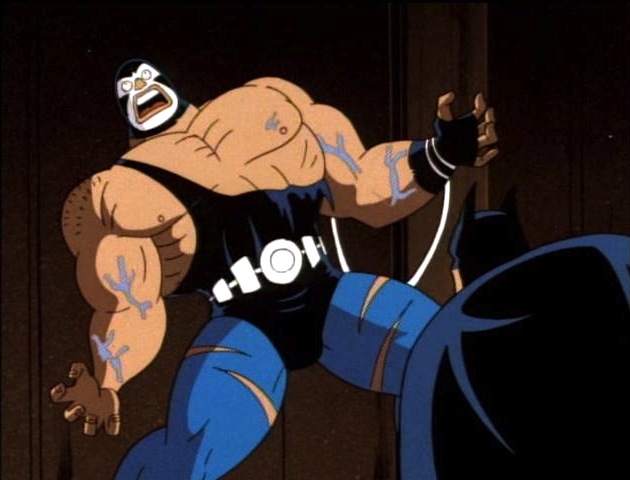
The episode plays lip service to the idea of Bane as a mental threat. Bane hints at ambitions beyond just killing Batman (at least he’s receptive to the idea when Thorne’s “assistant” Candice suggests Bane take over Thorne’s gang). And Bane says he’s going to study how Batman fights and thinks. But the idea of a patient Bane is thrown out of the window when, instead of letting Killer Croc fight Batman, Bane breaks through a wall, shouts “He is mine to destroy, monster!” and then puts Croc in traction.
Patient Bane would have let them fight and either seen Batman’s tactics against a superstrong opponent, or Croc would kill Batman and Bane would kill Croc, then take credit. Win-win. Instead, Bane acts like a muscle-brained idiot, gives away his identity to Batman, and worfs Croc in the process. Every time Bane shouts, especially every time he shouts about breaking Batman (three times), he sounds less like a master villain and more like an insecure thug who’s trying to believe his own hype. It’s telling that his last words are “You can’t do this to me. I am invincible, I am BANE” even as he’s crippled by a Venom OD.
Notably, Batman himself is never all that impressed with Bane. Batman even jokes off any concern about fighting the world’s greatest assassin. “He trashed my car, Alfred. Between a couple of guys that’s real personal.” That’s all this is to Batman, a pissing match between two tough dudes, not a life or death struggle for the soul of Gotham. Batman seems to be having fun this episode, which ends up being a little off-putting. Batman smiles while physically torturing a man in traction (okay, Croc in traction) and he exposes Candice’s deception to Thorne, only to then leave Candice to Thorne’s “mercy.” Show a little concern, Bruce.
It is an even more bizarre episode for Robin. He starts off okay, giving a good fight to Bane even though, narratively, he’s doomed to lose. Then he gets stripped shirtless, suspended by his hands and feet, and felt up by a dominating brunette. I’m pretty sure I’ve seen this video. It’s even weirder when, freed from his chains, he invites said brunette, who as far was we know has no combat training, to fight him in a pool with the utterly sexist “C’mere, sweetie.” And it’s weirdest that Robin then loses. Good going, Dick.
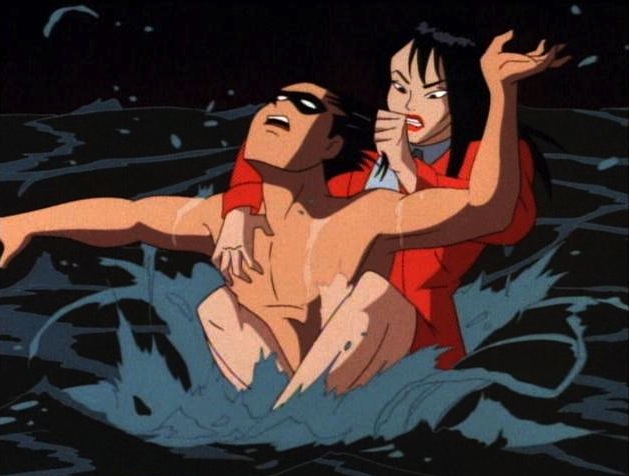
“Bane” is a good episode, one that really plays with the villain’s rep from the comics, but it uses up one of Batman’s best villains to tell a shaggy dog story. Bane ends up going out like a chump, and I end up agreeing with Batman’s assessment: “Is this the best you can throw at me?”
Steven Padnick is a freelance writer and editor. By day. You can find more of his writing and funny pictures at padnick.tumblr.com.










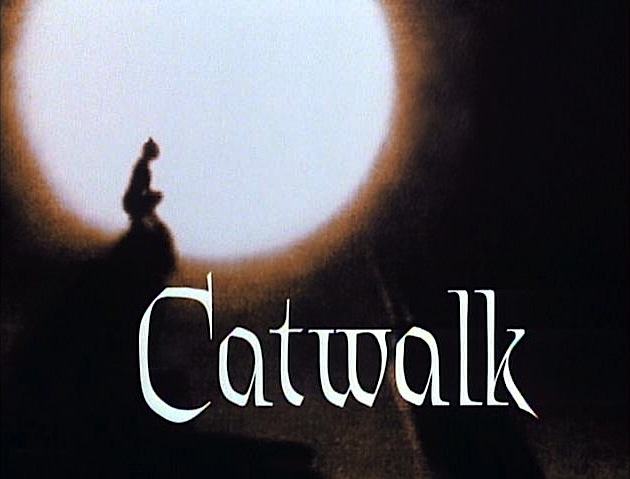
A quick note: A snafu on our end posted this a bit ahead of time. Look forward to “Harlequinade” and “Time Out Of Joint” next week!
“Catwalk” was the episode that really cemented my admiration for Boyd Kirkland as a director. I loved the character animation in the limo conversation, the subtle and rich play of expressions on Selina’s face. If animation is considered a form of acting, that was the best performance I ever saw on B:TAS.
“Bane” was underwhelming. I don’t have any particular feelings about it, beyond being glad to see Candice again and being annoyed at yet another violation of conservation of mass in cartoons (where does all the extra muscle mass come from?).
Bane’s my favorite Batman villain, and it’s entirely because of this episode. I was a huge wrestling fan as a kid and something about this massive luchador stuck with me. In hindsight the episode isn’t anything special, but I adored it when I was little and I’ve stuck with Bane through thick and thin since (and there was a whole lotta thin).
Bane was made into a somewhat goofy character which disappointed me when I first saw this. They coould’ve done a two parter with him, loosely adapting aspects of Knightfall. But I enjoy the episode as it is. The sexual tension between Robin and Candance was striking to me as well.
I recall from an interview at the time, Dini or Timm really hated Knightfall/Bane. They didn’t like that some new guy was created to be the one who “beats” Batman, rather than someone who had earned it like the Joker. Thus, this episode, which builds and builds and builds to the back breaking….and then Batman stabs him with a batarang and takes him out like a punk.
It’s a shame, because written well, Bane is a great villain (for one story*) but between this, Batman & Robin, Dark Knight Rises Then Trips Than Props Himself Up, he’s never gotten a good portrayal. Young Justice does an ok job, but by needs of the story, he still gets jobbed.
@5/Scavenger: I think TDKR’s portrayal of Bane was a perfectly valid interpretation of the character, definitely better than this version.